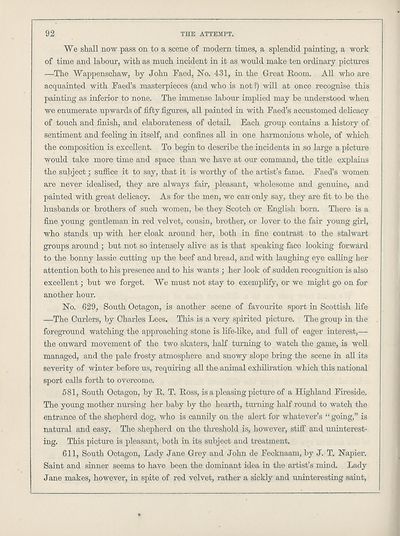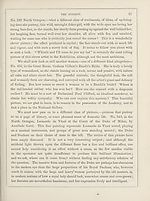Download files
Complete book:
Individual page:
Thumbnail gallery: Grid view | List view

92 THE ATTEMPT.
We shall now pass on to a scene of modern times, a splendid painting, a work
of time and labour, with as much incident in it as would make ten ordinary pictures
—The Wapjjenschaw, by John Faed, No. 431, in the Great Room. All who are
acquainted with Faed's masterpieces (and who is not 1) will at once recognise this
painting as inferior to none. The immense labour implied may be understood when
we enumerate upwards of fifty figures, all painted in with Faed's accustomed delicacy
of touch and finish, and elaborateness of detail. Each group contains a history of
sentiment and feeling in itself, and confines all in one harmonious whole, of which
the composition is excellent. To begin to describe the incidents in so large a picture
would take more time and space than we have at our command, the title explains
the subject; sufiice it to say, that it is worthy of the artist's fame. Faed's Avomen
are never idealised, they are always fair, pleasant, wholesome and genuine, and
painted with great delicacy. As for the men, we can only say, they are fit to be the
husbands or brothers of such women, be they Scotch or English born. There is a
fine young gentleman in red velvet, cousin, brother, or lover to the fair young girl,
who stands up with her cloak around her, both in fine contrast to the stalwart
groups around ; but not so intensely alive as is that speaking face looking forward
to the bonny lassie cutting up the beef and bread, and with laughing eye calling her
attention both to his presence and to his wants ; her look of sudden recognition is also
excellent; but we forget. We must not stay to exemplify, or we might go on for
another hour.
No. 629, South Octagon, is another scene of favourite sport in Scottish life
—The Curlers, by Charles Lees. This is a very spirited picture. The group in the
foreground watching the approaching stone is life-like, and full of eager interest,—
the onward movement of the two skaters, half turning to watch the game, is well
managed, and the pale frosty atmosphere and snowy slope bring the scene in all its
severity of winter before us, requiring all the animal exhiliration which this national
sport calls forth to overcome.
581, South Octagon, by E.. T. Ross, is a pleasing picture of a Highland Fireside.
The yoiing mother nursing her baby by the hearth, turning half round to watch the
entrance of the shepherd dog, who is cannily on the alert for whatever's " going," is
natural and easy. The shepherd on the threshold is, however, stifl" and uninterest¬
ing. This picture is pleasant, both in its subject and treatment.
Gil, South Octagon, Lady Jane Grey and John de Fecknaam, by J. T. Napier.
Saint and sinner seems to have been the dominant idea in the artist's mind. Lady
Jane makes, however, in spite of red velvet, rather a sickly and uninteresting saint,
We shall now pass on to a scene of modern times, a splendid painting, a work
of time and labour, with as much incident in it as would make ten ordinary pictures
—The Wapjjenschaw, by John Faed, No. 431, in the Great Room. All who are
acquainted with Faed's masterpieces (and who is not 1) will at once recognise this
painting as inferior to none. The immense labour implied may be understood when
we enumerate upwards of fifty figures, all painted in with Faed's accustomed delicacy
of touch and finish, and elaborateness of detail. Each group contains a history of
sentiment and feeling in itself, and confines all in one harmonious whole, of which
the composition is excellent. To begin to describe the incidents in so large a picture
would take more time and space than we have at our command, the title explains
the subject; sufiice it to say, that it is worthy of the artist's fame. Faed's Avomen
are never idealised, they are always fair, pleasant, wholesome and genuine, and
painted with great delicacy. As for the men, we can only say, they are fit to be the
husbands or brothers of such women, be they Scotch or English born. There is a
fine young gentleman in red velvet, cousin, brother, or lover to the fair young girl,
who stands up with her cloak around her, both in fine contrast to the stalwart
groups around ; but not so intensely alive as is that speaking face looking forward
to the bonny lassie cutting up the beef and bread, and with laughing eye calling her
attention both to his presence and to his wants ; her look of sudden recognition is also
excellent; but we forget. We must not stay to exemplify, or we might go on for
another hour.
No. 629, South Octagon, is another scene of favourite sport in Scottish life
—The Curlers, by Charles Lees. This is a very spirited picture. The group in the
foreground watching the approaching stone is life-like, and full of eager interest,—
the onward movement of the two skaters, half turning to watch the game, is well
managed, and the pale frosty atmosphere and snowy slope bring the scene in all its
severity of winter before us, requiring all the animal exhiliration which this national
sport calls forth to overcome.
581, South Octagon, by E.. T. Ross, is a pleasing picture of a Highland Fireside.
The yoiing mother nursing her baby by the hearth, turning half round to watch the
entrance of the shepherd dog, who is cannily on the alert for whatever's " going," is
natural and easy. The shepherd on the threshold is, however, stifl" and uninterest¬
ing. This picture is pleasant, both in its subject and treatment.
Gil, South Octagon, Lady Jane Grey and John de Fecknaam, by J. T. Napier.
Saint and sinner seems to have been the dominant idea in the artist's mind. Lady
Jane makes, however, in spite of red velvet, rather a sickly and uninteresting saint,
Set display mode to: Large image | Transcription
Images and transcriptions on this page, including medium image downloads, may be used under the Creative Commons Attribution 4.0 International Licence unless otherwise stated. ![]()
| Ladies' Edinburgh Debating Society publications > Attempt > Volume 3 > (106) Page 92 |
|---|
| Permanent URL | https://digital.nls.uk/104344504 |
|---|
| Attribution and copyright: |
|
|---|

